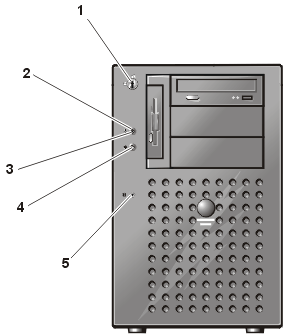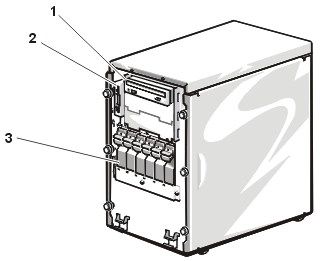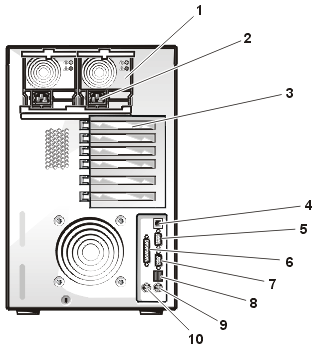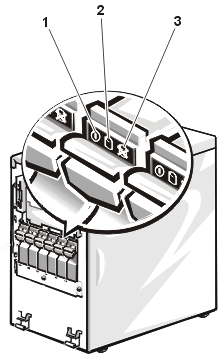Dell™ PowerEdge™ 1500SC Systems Service Manual
This section describes beep codes and system error messages that can occur during system start-up or, in the case of some failures, during normal system operation. The tables in this section list faults that can cause a beep code or system error message to occur and the probable causes of the fault in each case. This section also suggests actions you can take to resolve problems indicated by a message.
If a faulty system does not emit beep codes or display system error messages to indicate a failure, you should run the appropriate tests in the system diagnostics to help isolate the source of the problem. See "Running the System Diagnostics."
Several different types of messages can indicate when the system is not functioning properly:
System messages alert you to a possible operating system problem or to a conflict between the software and hardware. Table 1 lists the system error messages that can occur and the probable cause for each message.
If the table does not lead to the source of the problem, run the appropriate tests in the system diagnostics.
 |
NOTE: If you receive a system message that is not listed in Table 1, check the documentation for the application program that is running when the message appears and/or the operating system documentation for an explanation of the message and recommended action. |
|
Message |
Cause |
Corrective Action | |
|---|---|---|---|
Address mark not found | Faulty diskette, CD drive, or hard drive subsystem (defective system board). | ||
Alert! One or more of the memory DIMMs are out of rev. | Unsupported memory module(s) installed. | Replace one or more memory modules so that the memory module pairs are identical. | |
Alert! Processor thermal probe failure detected | Defective microprocessor. | Replace the microprocessor. If the problem persists, replace the VRM. | |
Alert! Secondary system fan was not detected | Loose PCI fan cable connection, defective fan. | Check the PCI fan cable. If the problem persists, replace the PCI fan shroud. | |
Alert! System fan was not detected | Loose fan cable connection, defective fan. | Check the front fan power cable. If the problem persists, replace the fan. | |
Alert! Unsupported memory in DIMM slot(s) A, B, C, or D | Unsupported memory module(s) installed in specified slot(s). | Replace one or more memory modules so that all memory module pairs are identical. | |
Attachment failed to respond | Diskette drive or hard drive controller cannot send data to associated drive. | Replace the drive's interface cable. If the problem persists, replace the diskette drive or hard drive. If the problem still persists, replace the system board. | |
Auxiliary device failure | Mouse cable connector loose or improperly connected, defective mouse. | Check the mouse cable connection. If the problem persists, replace the mouse. | |
Bad error-correction code (ECC) on disk read Controller has failed | Faulty diskette/tape drive, CD drive, or hard drive subsystem (defective system board). | See "Drives." Replace the diskette or hard drive. If the problem persists, replace the system board. | |
CD-ROM drive 0 not found | Improperly connected or missing CD drive. | Check that the interface cable is seated on the system board. Replace the drive. | |
Data error | Faulty diskette, diskette drive, or hard drive. | Replace the diskette, diskette drive, or hard drive. See "Drives." | |
Decreasing available memory | One or more memory modules improperly seated or faulty. | Remove and reseat the memory modules. If the problem persists, replace the memory modules. | |
Diskette drive 0 seek failure | Faulty or improperly inserted diskette, incorrect configuration settings in System Setup program, loose diskette interface cable, or loose power cable. | Replace the diskette. Run the System Setup program to correct the diskette drive type. See "Using the System Setup Program." Check the interface cable and power cable connections to the system board. See "Drives." | |
Diskette drive 1 seek failure | |||
Diskette read failure | Faulty diskette, faulty or improperly connected diskette drive, loose diskette/tape drive interface cable, or loose power cable. | Check the interface cable and power cable connections to the system board. See "Drives." | |
Diskette subsystem reset failed | Faulty diskette/tape drive controller (defective system board). | ||
Diskette write protected | Diskette write-protect feature activated. | Move the write-protect tab on the diskette. | |
Drive not ready | Diskette missing from or improperly inserted in diskette drive. | Reinsert or replace the diskette. | |
Gate A20 failure | Faulty keyboard controller (defective system board). | ||
General failure | Operating system corrupted or not installed properly. | Reinstall the operating system. | |
Hard disk controller failure | Incorrect configuration settings in System Setup program, improperly connected hard drive, faulty hard drive controller subsystem (defective system board), or loose power cable. | Check the hard drive configuration settings in the System Setup program. Reinstall the hard drive. Check the interface cable and power cable connections to the SCSI backplane board. | |
| |||
| |||
Keyboard failure | Keyboard cable connector loose or improperly connected, defective keyboard, or defective keyboard/mouse controller (defective system board). | Check the keyboard cable connection. Replace the keyboard. If the problem persists, replace the system board. | |
Keyboard data line failure | |||
Keyboard stuck key failure | |||
| |||
Keyboard controller failure | Defective keyboard/mouse controller (defective system board). | ||
Keyboard fuse has failed | Defective keyboard. | Replace the keyboard. | |
Memory address line failure at address, read value expecting value | Faulty or improperly seated memory modules or defective system board. | Remove and reseat the memory modules. If the problem persists, replace the memory modules. If the problem still persists, replace the system board. | |
| |||
Memory double word logic failure at address, read value expecting value | |||
Memory odd/even logic failure at address, read value expecting value | |||
Memory write/read failure at address, read value expecting value | |||
Memory allocation error | Faulty application program. | Restart the application program. | |
Memory parity interrupt at address | Improperly seated or faulty memory modules. |
| |
Memory tests terminated by keystroke | POST memory test terminated by pressing the spacebar. | No action is required. | |
No boot device available | Faulty diskette, diskette/tape drive subsystem, hard drive, hard drive subsystem, or no boot disk in drive A. | If booting from a diskette, ensure the diskette is bootable. If booting from a hard drive, replace the hard drive. If the problem persists, replace the system board. | |
No boot sector on hard-disk drive | Incorrect configuration settings in System Setup program, or no operating system on hard drive. | Check the hard drive configuration settings in the System Setup program. Install an operating system on the hard drive. | |
No timer tick interrupt | Defective system board. | ||
Non-system disk or disk error | Faulty diskette, diskette/tape drive subsystem, or hard drive subsystem. | Ensure the diskette is a bootable diskette. If booting from a hard drive, ensure the hard drive is formatted and contains an operating system. Replace the system board. | |
Not a boot diskette | No operating system on diskette. | Use a bootable diskette. | |
Processors with different speeds detected. System halted! | Two different types of microprocessors are installed. | Replace one of the microprocessors so that both are the same type. See "Microprocessor" for instructions. | |
Read fault | Faulty diskette, diskette/tape drive subsystem, or hard drive subsystem. | Replace the diskette or hard drive. See "Drives." If the problem persists, replace the system board. | |
Reset failed | Improperly connected diskette/tape drive, hard drive, or power cable. | Check that cables are securely connected. If the problem persists, replace the system board. | |
ROM bad checksum = address | Expansion card improperly installed or faulty. | Check that the expansion cards are fully seated. Reinstall the expansion cards. If the problem persists, replace the expansion card. If the problem still persists, replace the system board. | |
Sector not found | Defective sectors on diskette or hard drive. | Replace the diskette or hard drive. See "Drives." | |
Seek operation failed | Faulty diskette or hard drive. | Replace the diskette or hard drive. See "Drives." | |
Shutdown failure | Defective system board. | ||
Time-of-day clock stopped | Defective battery or faulty chip. | Replace the system battery. See "Replacing the System Battery" in "Installing System Board Options." | |
Time-of-day not set - please run SETUP program | Incorrect Time or Date settings or defective system battery. | Check the Time and Date settings. See "Using the System Setup Program" for instructions. If the problem persists, replace the battery. If the problem still persists, replace the system board. | |
Timer chip counter 2 failed | Defective system board. | See "Using the System Setup Program" for instructions. | |
Unexpected interrupt in protected mode | Improperly seated memory modules or faulty keyboard/mouse controller chip. | Remove and reseat the memory modules. If the problem persists, replace the memory modules. If the problem still persists, replace the system board. | |
Write fault | Faulty diskette or hard drive. | Replace the diskette or hard drive. See "Drives." |
When an error that cannot be reported on the monitor occurs during a boot routine, the system may emit a series of beeps that identify the problem. The beep code is a pattern of sounds; for example, one beep followed by a second beep and then a burst of three beeps (code 1-1-3) means that the computer was unable to read the data in NVRAM. This information is valuable to the Dell technical support representative if you need to call for technical assistance.
| NOTE: If the system boots without a keyboard, mouse, or monitor attached, the system will not issue beep codes related to these peripherals. |
When a beep code is emitted, record it on a copy of the Diagnostics Checklist, and then look it up in Table 2. If you are unable to resolve the problem by looking up the meaning of the beep code, use the system diagnostics to identify a more serious cause. See "Running the System Diagnostics."
Table 2. System Beep Codes
| Code | Cause | Corrective Action |
|---|---|---|
| 1-1-3 | CMOS write/read failure | Replace the system board. |
| 1-1-4 | BIOS checksum failure | Reflash the BIOS firmware. If the problem persists, replace the system board. |
| 1-2-1 | Programmable interval-timer failure | Replace the system board. |
| 1-2-2 1-2-3 |
DMA initialization failure DMA page register write/read failure |
Remove and reseat the memory modules. If the problem persists, replace one or more memory modules. If the problem still persists, replace the system board. |
| 1-3-1 | Main-memory refresh verification failure | Remove and reseat the memory modules. If the problem persists, replace one or more memory modules. If the problem still persists, replace the system board. |
| 1-3-2 | No memory installed | Remove and reseat the memory modules. If the problem persists, replace the memory modules. If the problem still persists, replace the system board. |
| 1-3-3 1-3-4
1-4-1
1-4-2 2-1-1 |
Chip set or data
line failure in the first 64 KB of main memory Odd/even logic failure in the first 64 KB of main memory Address line failure in the first 64 KB of main memory Parity failure in the first 64 KB of main memory Bit failure in the first 64 KB of main memory |
Remove and reseat the memory modules. If the problem persists, replace the memory modules. If the problem still persists, replace the system board. |
| 3-1-1
3-1-3 3-1-4 |
Slave
DMA-register failure Master DMA-register failure Master interrupt-mask register failure Slave interrupt-mask register failure |
Replace the system board. |
| 3-2-4 | Keyboard-controller test failure | Check the keyboard cable and connector for proper connection. If the problem persists, run the keyboard test in the diagnostics to determine whether the keyboard or keyboard controller is faulty. If the keyboard controller is faulty, replace the system board. |
| 3-3-1 | CMOS failure | Run the system board test in the diagnostics to isolate the problem. |
| 3-3-2 | System configuration check failure | Replace the system board. |
| 3-3-3 | Keyboard controller not detected | Replace the system board. |
| 3-3-4
3-4-2 3-4-3 |
Screen
initialization failure Screen-retrace test failure Search for video ROM failure |
Run the video tests in the diagnostics. |
| 4-2-1 4-2-2 4-2-3 |
No timer tick
Shutdown failure Gate A20 failure |
Replace the system board. |
| 4-2-4 | Unexpected interrupt in protected mode | Ensure that all expansion cards are properly seated, and then reboot the system. |
| 4-3-1 | Improperly seated or faulty memory modules | Remove and reseat the memory modules. If the problem persists, replace the memory modules. If the problem still persists, replace the system board. |
| 4-3-3 | Defective system board | Replace the system board. |
| 4-3-4 | Time-of-day clock stopped | Replace the battery. If the problem persists, replace the system board. |
| 4-4-1 | Super I/O chip failure (defective system board) | Replace the system board. |
| 4-4-2 | Parallel- port test failure (defective system board) | Replace the system board. |
| 4-4-3 | Math coprocessor failure (defective microprocessor) | Remove and reseat the specified microprocessor. If the problem still persists, replace the microprocessor. |
A warning message alerts you to a possible problem and asks you to take corrective action before the system continues a task. For example, before you format a diskette, a message might warn you that you might lose all data on the diskette, as a way to protect against inadvertently erasing or writing over the data. These warning messages usually interrupt the procedure and require you to respond by typing y (yes) or n (no).
 |
NOTE: Warning messages are generated by either the application program or the operating system. See your Installation and Troubleshooting Guide and the documentation that accompanied the operating system and application program for more information on warning messages. |
When you run a test group or subtest in the system diagnostics, an error message might result. These particular error messages are not covered in this section. Record the message on a copy of the Diagnostics Checklist (located in "Getting Help" in the Installation and Troubleshooting Guide, and then follow the instructions in that section for obtaining technical assistance.
The optional server management software generates alert messages for your system. For example, the server agent generates messages that appear in the SNMP trap log file. Alert messages consist of information, status, warning, and failure messages for drive, temperature, fan, and power conditions. More information about alert messages is provided in the system management software documentation found on the documentation CD that shipped with your system.
The following controls and status indicators are on the system's bezel and front panel (see Figure 1, Figure 2 and Table 3):
Figure 1. Bezel Controls and Indicators
 |
|
Figure 2. Front Panel Features
 |
|
Table 3. Front Bezel and Front Panel Indicator Patterns
| Indicator | Description |
|---|---|
| Hard-drive activity | Green LED blinks when activity is detected on the hard drives. |
| Power-on indicator | LED displays a steady green light when the power supply is turned on. |
The following features and indicators are on the system's back panel (see Figure 3 and Table 4):
 |
|
Table 4. Back-Panel Indicator Patterns
| Indicator | Description |
|---|---|
| NIC (2 LEDs) | LEDs display a steady
green light when a link is detected. They flicker when network activity is detected. |
If an approved RAID controller is installed in the system, two LED indicators on each of the hard drive carriers provide information on the status of the SCSI hard drives (see Figure 4). The SCSI backplane firmware controls the "drive online" and "drive failure" indicator indicators.
Figure 4. Hard-Drive Indicators
 |
|
Table 5 lists the drive indicator patterns established by the SCSI backplane firmware. Different patterns are displayed as drive events occur in the system. For example, in the event of a hard drive failure, the "drive failed" pattern appears. After the drive is selected for removal, the "drive being prepared for removal" pattern appears, followed by the "drive ready for insertion or removal" pattern. After the replacement drive is installed, the "drive being prepared for operation" pattern appears, followed by the "drive online" pattern.
 |
NOTE: If you do not have the optional
integrated RAID controller, or an optional PCI RAID controller installed, you will see
only the "drive online" and "drive bay empty" indicator patterns. |
Table 5. SCSI Hard Drive Indicator Patterns
| Condition | Indicator Code |
|---|---|
| Identify drive | All three drive status indicators blink simultaneously. |
| Drive being prepared for removal | All three drive status indicators flash sequentially. |
| Drive ready for insertion or removal | All three drive status indicators are off. |
| Drive being prepared for operation | The drive online indicator is on. The drive activity light may flash briefly. |
| Drive bay empty | All three drive status indicators are off. |
| Drive predicted failure | The drive online indicator is on. The drive failure indicator blinks briefly each second. |
| Drive failed | The drive online indicator is off. The drive failure indicator blinks off briefly each second. |
| Drive rebuilding | The drive online indicator blinks rapidly. |
| Drive online | The drive online indicator is on. |
Each power supply has two indicators, which indicate the power-on status and fault. These power supplies are hot-pluggable (see Figure 5 and Table 6).
Figure 5. Redundant Power Supply Features
 |
|
Table 6 lists the power supply indicator patterns for a redundant, hot-pluggable power supply.
Table 6. Power Supply Indicator Patterns
| Indicator | Description |
|---|---|
| Power-on | Green indicator indicates that the power supply is operational. |
| Fault | Red indicator indicates a problem with the power supply, such as fan failure, voltage level error, or other fault. |